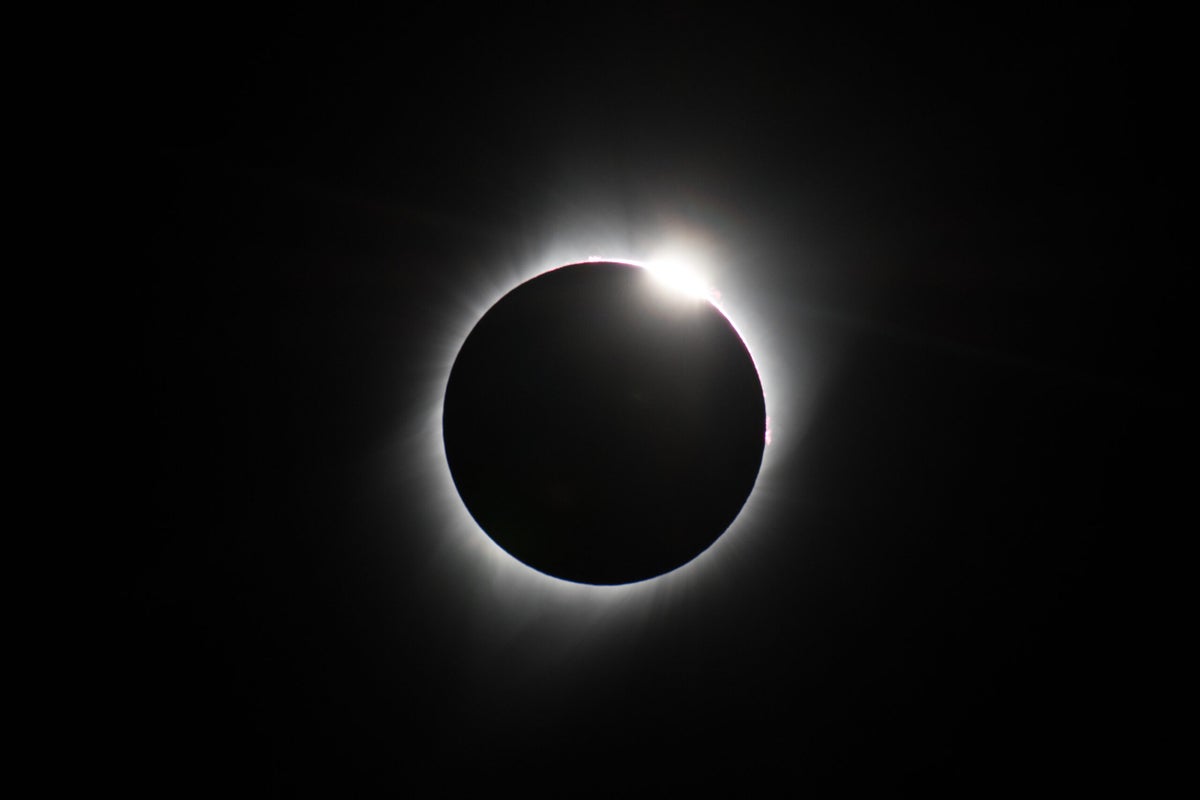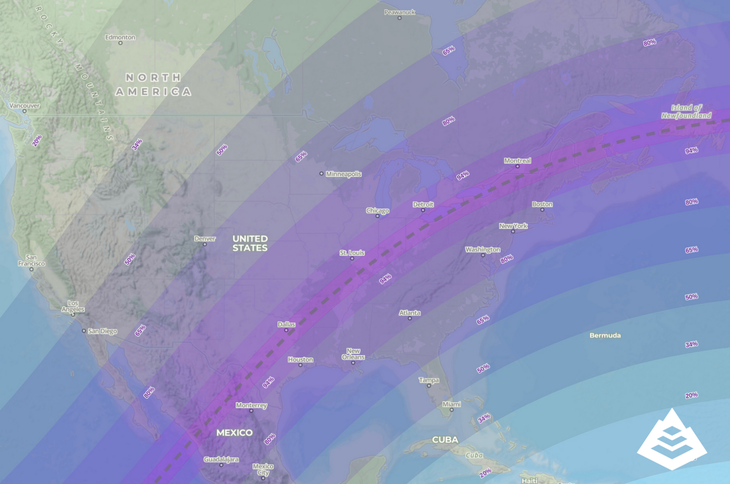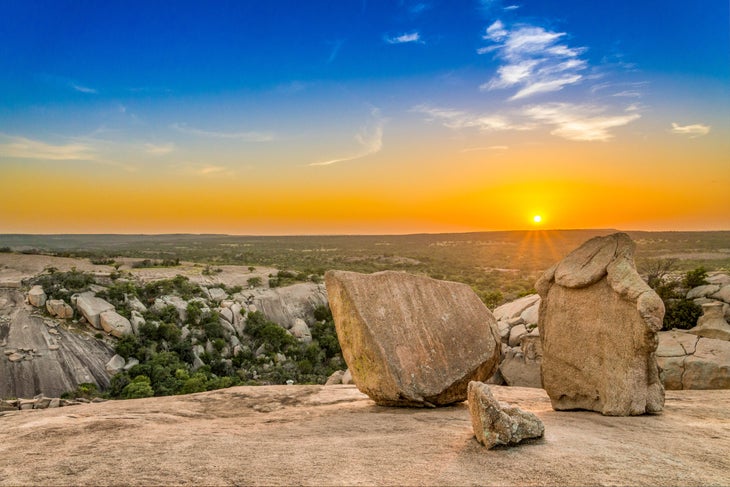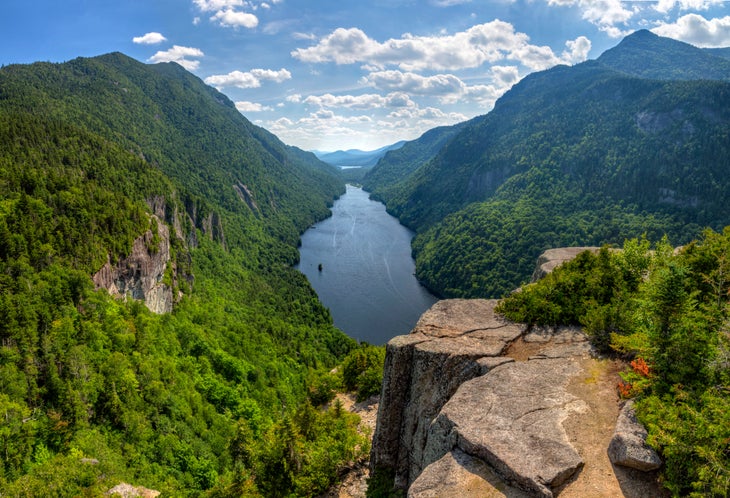View the 2024 Solar Eclipse From These Five Crags

On April 8, a large swathe of North America will be in the path of a total solar eclipse. This rare celestial phenomena, which occurs when the moon passes completely in front of the sun, won’t be visible in the contiguous United States again until 2044, so it’s worth a gander if you can spare a few moments from your project.
Several popular climbing destinations sit smack-dab in the middle of the eclipse’s path of totality, the stretch where the moon’s coverage of the sun is 100 percent. So depending on where you live (or how far you’re willing to drive), you may have the unique opportunity to experience this year’s eclipse out at the crag.

Let’s talk about what exactly a “total solar eclipse” is, answer a few questions you might have, and then give the climber’s lowdown, detailing the crags which will give you a perfect view of this brief period of lunar supremacy.
What is a Total Solar Eclipse?
A total solar eclipse happens when the moon lines up perfectly between the earth and the sun, completely blocking the sun’s light. This briefly casts a small band of the earth into deep twilight, even though it might be the middle of the day. From Earth, the silhouette of the moon will be framed by the sun’s corona, a faint, wispy aura normally hidden by the sun’s light.
It might seem odd that Earth’s tiny moon can obscure the sun. Although the sun is about 400 times larger across than the moon, it is also about 400 times further away, making the two celestial bodies appear to be the same size.
Total solar eclipses are visible somewhere on Earth around every 18 months. But a given location on Earth will experience a path of totality much more infrequently. Statisticians say it takes an average of 375 years for a total eclipse to revisit a given destination. An estimated 32 million people live inside the U.S. path of totality for this eclipse, which is part of the reason eclipse expert Michael Zeiler says it will be “the most-viewed astronomical event in American history.”
Tips for Viewing the Solar Eclipse
First and foremost, do not attempt to view the eclipse without glasses. Staring at the sun with the naked eye can lead to permanent eye damage, sometimes after just a few seconds. Most people realize this under normal circumstances. (If you look up at the sun on a clear day, your eyes will hurt almost instantly.)
The difference is that during an eclipse, your eye is “tricked” into letting its guard down. The majority of the light from the sun is obscured, so your pupils expand to adjust for the low light, just like they do when adjusting to the light in a dim room or cave. However, the UV radiation from the sun remains high, and can still cause serious carnage to your cornea and retina. Don’t risk it!
You can find safe solar eclipse glasses and viewers all over the internet, including on Amazon. Just make sure they’re authentic before you purchase. Look for International Organization Standardization certification and the label “ISO 12312-2.” Visit the American Astronomical Society website to find more information and a list of authorized eclipse glasses retailers.
How long will the solar eclipse last?
Most places inside the path of totality will experience between 3.5 and 4 minutes of full eclipse. The eclipse will last the longest in south-central Texas, near Kerrville and Fredericksburg, where total coverage is expected to last 4.5 minutes.
What Major Crags are in the Path of Totality?
The April 8 solar eclipse will pass over the United States in a northeasterly direction, entering near Eagle Pass in southwestern Texas at 1:27pm (CDT), then passing over Arkansas, Missouri, Illinois, Indiana, Ohio, Pennsylvania, New York, Vermont, and New Hampshire before leaving out of northeastern Maine at 3:32pm (EDT). Bits of Oklahoma, Kentucky, and Pennsylvania also lie within the path of totality, which is around 115 miles wide.
Below are a few of the most well-known climbing crags in the path of totality, as well as the time the eclipse is expected to occur over them.
Enchanted Rock State Natural Area: 1:32 p.m. (CDT)
A stone’s throw away from Fredericksburg, the 425-foot major dome of Enchanted Rock, Texas, is perhaps the best wall for climbers to view the eclipse, with full coverage lasting nearly 4.5 minutes. Enchanted has some 350 climbs and a diversity of disciplines, though easy-to-moderate trad classics like Sweat (5.7), Cave Crack (5.6), Owl Crack (5.8), and Fear of Flying (5.10) are what most folks come for.
NOTE: Texas is the crown jewel of the eclipse this year, and has several other crags in the path of totality, including a lot of the climbing around Austin, such as Reimers Ranch.

Jamestown, Arkansas: 1:52 p.m. (CDT)
Arkansas’ popular Horseshoe Canyon Ranch is on the edge of the path of totality, but climbers looking for better coverage (4 minutes) will need to head southeast, to the smaller sport crag of Jamestown. This climber-owned sandstone crag features around 100 sport routes. Don’t miss Pee Green (5.9), Flamin’ Piss (5.10c), F.O.A. (5.11b), and Grunge Fest (5.11c).
Holy Boulders, Illinois: 1:59 p.m. (CDT)
Like Enchanted Rock, the Holy Boulders of Illinois are positioned for some really stellar eclipse viewing, with 4 minutes and 10 seconds of totality, though you probably won’t get the clear lines of sight you can find on the lofty walls of Enchanted.
When you factor in nearby House Boulders, Hagler, and the Hellhole sinkhole, there are over 350 established problems littered throughout this tract of land on the edge of Shawnee National Forest. Shadow of a Man (V5) is a must-do at the grade. Other notables include The Mollusk and sketchy Anthrax Arête (V2), Enlightenment (V4), and the ultraclassic swinger Jungle Book (V8).
The Adirondacks, New York: 3:15 to 3:25 p.m. (EDT)
From Indian Lake to the High Peaks, there is a staggering amount of climbing in the six million-acre wilderness of the Adirondacks, and almost all of it is within the 2024 solar eclipse’s path of totality. The eclipse will hit each of these areas at a slightly different time, but will begin over Buffalo around 3:18 p.m. (EDT) and hit the Lake Champlain area at 3:25 p.m. Get up high, get clear of the trees, and slap on those glasses!

Burlington, Vermont: 3:26 p.m. (EDT)
Like the Adirondacks, Burlington is near the center of the eclipse’s path of totality. The duration up here isn’t as long as it is down in Texas and Arkansas, but you’ll still get to experience around three minutes of full solar eclipse at the famous boulders of Smugglers’ Notch (the V1 The Fin and V6 Boomerang are two must-trys) and the array of crags around Bolton, such as F – North End, home to stellar trad hand cracks The Rose (5.10) and The Thorn (5.11).
Also Read
The post View the 2024 Solar Eclipse From These Five Crags appeared first on Climbing.

